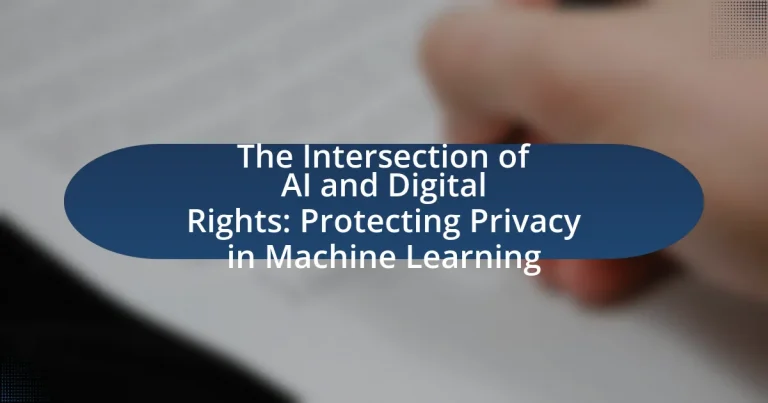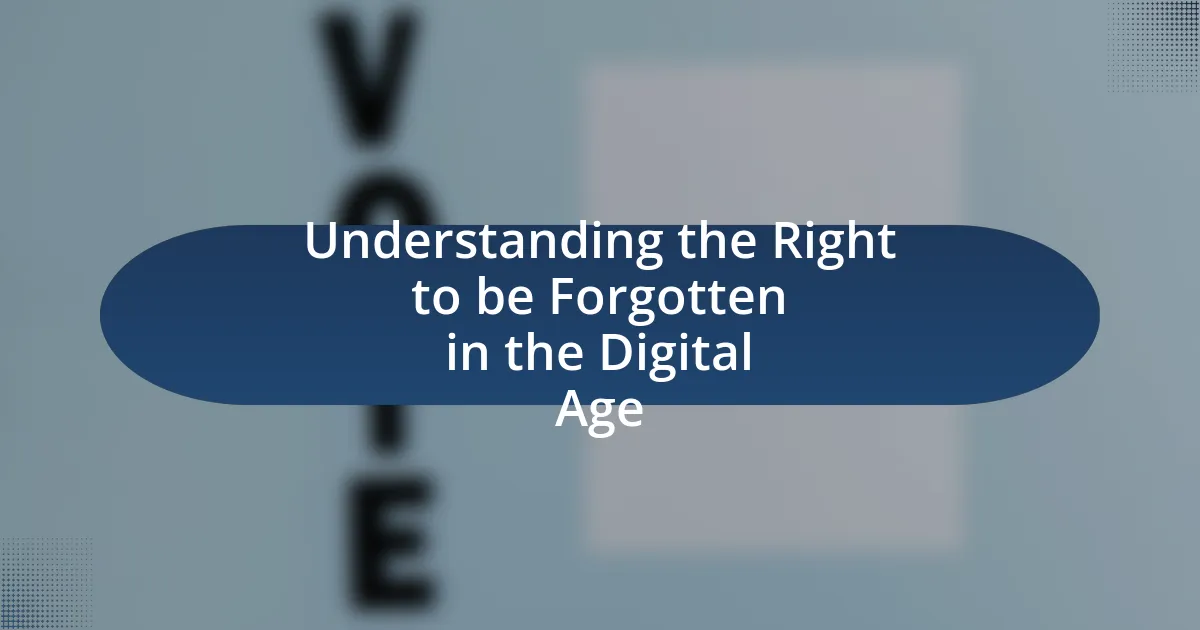The article examines the intersection of artificial intelligence (AI) and digital rights, focusing on the ethical and legal implications of AI technologies on individual privacy and data protection. It highlights how AI systems, which often require extensive personal data, can infringe on privacy rights and raise concerns about data ownership and surveillance. Key digital rights affected include the right to privacy, data protection, and non-discrimination, with discussions on the challenges AI poses to existing legal frameworks. The article also addresses the responsibilities of AI developers in safeguarding privacy, the importance of robust legal regulations like the General Data Protection Regulation (GDPR), and best practices for implementing privacy protection in machine learning.

What is the Intersection of AI and Digital Rights?
The intersection of AI and digital rights involves the ethical and legal implications of artificial intelligence technologies on individual privacy and data protection. AI systems often require vast amounts of personal data to function effectively, raising concerns about how this data is collected, stored, and used. For instance, the General Data Protection Regulation (GDPR) in Europe establishes strict guidelines on data processing, emphasizing the rights of individuals to control their personal information. This regulatory framework highlights the necessity for AI developers to ensure compliance with digital rights, thereby protecting user privacy while leveraging machine learning capabilities.
How do AI technologies impact digital rights?
AI technologies significantly impact digital rights by raising concerns about privacy, data ownership, and surveillance. The deployment of AI systems often involves the collection and processing of vast amounts of personal data, which can infringe on individuals’ rights to privacy as outlined in various legal frameworks, such as the General Data Protection Regulation (GDPR) in Europe. For instance, AI algorithms can analyze user behavior and preferences without explicit consent, leading to potential violations of data protection laws. Furthermore, the use of AI in surveillance technologies can lead to increased monitoring of individuals, which poses risks to civil liberties and freedom of expression. These implications highlight the need for robust legal frameworks and ethical guidelines to safeguard digital rights in the age of AI.
What are the key digital rights affected by AI?
The key digital rights affected by AI include the right to privacy, the right to data protection, and the right to non-discrimination. AI technologies often process vast amounts of personal data, which can infringe on individuals’ privacy rights by enabling surveillance and unauthorized data collection. For instance, the General Data Protection Regulation (GDPR) in the European Union emphasizes the importance of data protection, highlighting that individuals have the right to control their personal information. Additionally, AI systems can perpetuate biases, leading to discrimination against certain groups, thereby impacting the right to equality and non-discrimination. Studies have shown that biased algorithms can result in unfair treatment in areas such as hiring and law enforcement, underscoring the need for ethical AI practices to safeguard these digital rights.
How does AI challenge existing frameworks of digital rights?
AI challenges existing frameworks of digital rights by introducing complexities in data ownership, consent, and privacy. Traditional digital rights frameworks often rely on clear definitions of data ownership and user consent, but AI systems frequently utilize vast amounts of data from various sources, making it difficult to ascertain who owns the data and whether consent has been appropriately obtained. For instance, machine learning algorithms can analyze personal data without explicit user consent, leading to potential violations of privacy rights as outlined in regulations like the General Data Protection Regulation (GDPR). Additionally, the opacity of AI decision-making processes complicates accountability, as users may not understand how their data is being used or how decisions affecting them are made. This lack of transparency undermines the principles of informed consent and user agency that are foundational to existing digital rights frameworks.
Why is privacy a critical concern in machine learning?
Privacy is a critical concern in machine learning because the technology often relies on vast amounts of personal data to train algorithms, which can lead to unauthorized access and misuse of sensitive information. The collection and processing of personal data can result in privacy violations, as seen in cases like the Cambridge Analytica scandal, where personal data from millions of Facebook users was harvested without consent for political advertising. Additionally, regulations such as the General Data Protection Regulation (GDPR) emphasize the importance of protecting individuals’ privacy rights, mandating that organizations implement strict data protection measures. This legal framework highlights the necessity for transparency and accountability in how machine learning systems handle personal data, making privacy a fundamental issue in the development and deployment of these technologies.
What role does data collection play in privacy issues?
Data collection is central to privacy issues as it involves the gathering of personal information that can be misused or inadequately protected. When organizations collect data, they often accumulate sensitive information about individuals, which raises concerns about consent, security, and potential breaches. For instance, a 2020 report by the Pew Research Center found that 79% of Americans are concerned about how their data is being used by companies, highlighting the widespread apprehension regarding privacy. Furthermore, inadequate data protection measures can lead to unauthorized access and exploitation of personal data, exacerbating privacy risks. Thus, the role of data collection in privacy issues is significant, as it directly influences the extent to which individuals can maintain control over their personal information.
How do machine learning algorithms process personal data?
Machine learning algorithms process personal data by analyzing large datasets to identify patterns and make predictions. These algorithms utilize techniques such as supervised learning, where labeled data is used to train models, and unsupervised learning, which finds hidden structures in unlabeled data. For instance, in supervised learning, personal data like age, gender, and purchase history can be used to predict future buying behavior. The algorithms extract features from this data, transforming it into a format suitable for analysis, while ensuring compliance with data protection regulations like GDPR, which mandates that personal data is processed lawfully, transparently, and for specific purposes.
What are the ethical implications of AI on privacy?
The ethical implications of AI on privacy include the potential for unauthorized data collection and surveillance. AI systems often require vast amounts of personal data to function effectively, which raises concerns about consent and the extent to which individuals are aware of how their information is being used. For instance, a study by the Electronic Frontier Foundation highlights that AI technologies can enable pervasive monitoring, leading to a significant erosion of personal privacy. Furthermore, the use of AI in decision-making processes can result in biased outcomes based on the data collected, which may disproportionately affect marginalized groups. These factors underscore the need for robust ethical guidelines and regulations to protect individual privacy rights in the age of AI.
How can bias in AI systems affect individual privacy rights?
Bias in AI systems can significantly undermine individual privacy rights by leading to discriminatory data practices and unjust profiling. When AI algorithms are trained on biased datasets, they may disproportionately target specific demographic groups, resulting in invasive surveillance and data collection practices that violate privacy. For instance, a study by ProPublica revealed that biased algorithms in criminal justice systems led to higher false positive rates for minority groups, which can result in increased scrutiny and data gathering on these individuals without just cause. This not only infringes on their privacy rights but also perpetuates systemic inequalities.
What responsibilities do AI developers have regarding privacy?
AI developers have the responsibility to ensure that user data is collected, processed, and stored in compliance with privacy laws and ethical standards. This includes implementing data minimization practices, where only necessary data is collected, and ensuring that users are informed about how their data will be used. Additionally, developers must incorporate robust security measures to protect data from unauthorized access and breaches. Compliance with regulations such as the General Data Protection Regulation (GDPR) mandates that developers provide users with rights to access, rectify, and delete their personal information. These responsibilities are crucial for maintaining user trust and safeguarding individual privacy in the rapidly evolving landscape of machine learning.
How can we protect privacy in the age of AI?
To protect privacy in the age of AI, implementing robust data protection regulations is essential. Regulations like the General Data Protection Regulation (GDPR) in Europe set strict guidelines on data collection, processing, and storage, ensuring individuals have control over their personal information. Additionally, employing privacy-preserving technologies such as differential privacy and federated learning can minimize data exposure while still allowing AI systems to learn from aggregated data. These methods have been shown to effectively reduce the risk of personal data breaches while maintaining the utility of AI applications.
What legal frameworks exist to safeguard digital rights?
Legal frameworks that exist to safeguard digital rights include the General Data Protection Regulation (GDPR) in the European Union, the California Consumer Privacy Act (CCPA) in the United States, and various international treaties such as the International Covenant on Civil and Political Rights (ICCPR). The GDPR, effective since May 2018, provides comprehensive data protection rights for individuals, including the right to access personal data and the right to erasure. The CCPA, enacted in 2018, grants California residents rights regarding their personal information, including the right to know what data is collected and the right to opt-out of its sale. The ICCPR, adopted in 1966, emphasizes the protection of privacy as a fundamental human right, influencing national laws and policies globally. These frameworks collectively establish legal standards for data protection and privacy, ensuring that individuals’ digital rights are recognized and upheld.
How can organizations implement privacy-by-design in AI systems?
Organizations can implement privacy-by-design in AI systems by integrating privacy considerations into every stage of the AI development lifecycle. This approach involves conducting privacy impact assessments during the design phase, ensuring data minimization by only collecting necessary information, and employing techniques such as anonymization and encryption to protect personal data. Additionally, organizations should establish clear data governance policies and provide transparency to users about data usage, as mandated by regulations like the General Data Protection Regulation (GDPR). Research indicates that organizations that adopt privacy-by-design principles not only comply with legal requirements but also enhance user trust and mitigate risks associated with data breaches.
What are the challenges in enforcing digital rights in AI?
Enforcing digital rights in AI faces significant challenges, primarily due to the complexity of technology and the evolving nature of regulations. The rapid advancement of AI technologies often outpaces existing legal frameworks, making it difficult to apply traditional privacy laws effectively. For instance, the General Data Protection Regulation (GDPR) in Europe provides guidelines for data protection, but its application to AI systems, particularly in terms of algorithmic transparency and accountability, remains ambiguous. Additionally, the lack of standardized definitions for key concepts such as “data ownership” and “consent” complicates enforcement efforts. Furthermore, the global nature of AI development means that differing national regulations can create jurisdictional conflicts, hindering consistent enforcement of digital rights across borders.
How do jurisdictional issues complicate digital rights enforcement?
Jurisdictional issues complicate digital rights enforcement by creating legal ambiguities regarding which laws apply to data and privacy violations. Different countries have varying regulations, such as the General Data Protection Regulation (GDPR) in the European Union and the California Consumer Privacy Act (CCPA) in the United States, leading to conflicts in enforcement. For instance, a company operating across borders may find it challenging to comply with multiple legal frameworks, resulting in inconsistent protection for individuals’ digital rights. This complexity is further exacerbated by the global nature of the internet, where data can be stored and processed in multiple jurisdictions, making it difficult to determine the applicable legal authority and enforce penalties effectively.
What technological barriers exist in protecting privacy?
Technological barriers in protecting privacy include inadequate encryption methods, insufficient data anonymization techniques, and the pervasive nature of surveillance technologies. Inadequate encryption can lead to unauthorized access to sensitive information, as evidenced by numerous data breaches where weak encryption protocols were exploited. Insufficient data anonymization allows for re-identification of individuals from supposedly anonymized datasets, which has been demonstrated in studies showing that 87% of individuals can be re-identified from a dataset with just a few data points. Additionally, the widespread use of surveillance technologies, such as facial recognition systems, raises significant privacy concerns, as these systems can track individuals without their consent, leading to potential misuse of personal data.
What best practices can be adopted for privacy protection in machine learning?
Best practices for privacy protection in machine learning include data anonymization, differential privacy, and secure data storage. Data anonymization involves removing personally identifiable information from datasets, which reduces the risk of re-identification. Differential privacy adds noise to the data or the results of queries, ensuring that individual data points cannot be discerned, thus protecting user privacy while still allowing for useful insights. Secure data storage practices, such as encryption and access controls, safeguard sensitive information from unauthorized access. These methods are supported by research indicating that implementing such practices significantly mitigates privacy risks in machine learning applications.





